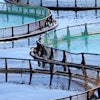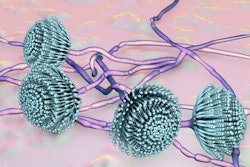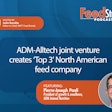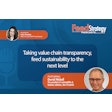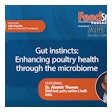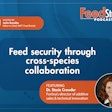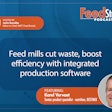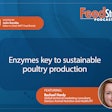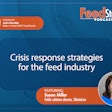
How digital tools can enhance layer performance (10:12)
Ann Reus: Hello and welcome to the Feed Strategy podcast. I’m your host, Feed Strategy senior reporter Ann Reus.
Rob Payne is director of poultry nutrition and technical services at Cargill Animal Nutrition in North America. He will be speaking at this year’s Poultry Tech Summit about how digital tools such as near-infrared imaging and cloud-based data management can improve layer performance. He recently joined me to talk about these topics. Here’s our conversation.
Hi, Rob. Thanks for being here today.
Rob Payne: Thanks, Ann. It’s a pleasure.
Reus: What will your talk at Poultry Tech Summit be about?
Payne: Yeah, my talk’s going to focus on how we manage data, especially we’re going to look at laying hens, how we manage data, how we generate the data using one of the tools that I’ll talk about, and then how do we manage that data and, ultimately, use that data to help make decisions about the nutrition program, about management, daily management practices, etc.
Reus: Explain how NIR, or near-infrared, imaging can be used to monitor poultry health and performance.
Payne: Yeah, so historically, when we think of NIR, we generally think of it as being used to help us analyze ingredients for their nutritive value and things. But NIR is a really fascinating tool that can be applied in a lot of different ways. And one of the ways we’re going to focus on is taking that NIR, collecting scans of a live animal, in this case, a laying hen. And we’ve developed calibrations that specifically help us measure the fat pad in that laying hen and, from that, knowing the fat pad can help us make decisions about the nutrition program. And so NIR is a great platform because it is going to measure organic bonds. It doesn’t it’s not specific to ingredients or live animal, so it has a lot of functionality that that we’re just now beginning to understand in the in the live animal space
Reus: What does the fat pad in layers tell you about the bird?
Payne: So in laying hens, fat pad, and this is true for most animals, but fat pad gives us an indication of the quality of the diet they’re being fed or if they’re being fed too much or not enough, because we’ll tell if they’re, are they storing a lot of fat orr are they storing a little fat. On the swine side, quite often we ultrasound, pigs to measure 10th rib back fat, it’s for a similar purpose, and we measure back fat on sows for similar body conditioning assessments. In this case, in laying hens, we’re measuring that fat pad to give us a clear indication of, does the laying hen, is she building up enough stores that she can produce an egg for a long period of time? Because we’re asking these hens to produce for, in some cases, 100, 120, 130 weeks and beyond. So is she in sufficient body score to be able to maintain that? Is she getting enough nutrients in her diet week in and week out to allow her to maintain that level of performance that we’re asking her to do?
Reus: So, at PTS you’ll be talking about this cloud-based management tool. What is it and how does it work?
Payne: So the data we were just talking about on measuring the fat pad, ultimately that’s going to go up. The calibrations that that are built around assessing that, on the one hand, are cloud based. And so we’re going to be able to make those calculations more or less on the fly to go from taking and capturing a scan using an NIR and putting it through a calibration and coming up with an answer almost instantaneously. So that’s one way we’re going to use the cloud. And the other way we’re going to talk about is we collect lots of data in laying hen performance, number of eggs per day, hen persistency, feed intake, water intake, all kinds of variables that we collect, and being able to store this data and put this data into a cloud-based database that we then can use to assess the performance of that bird, to be able to get to it easily no matter where we are, to be able to assess the performance and then be able to make real-time decisions on the data we’re seeing. Cloud enables us to do that much easier. And it allows us, say, multiple people – if we want to have a veterinarian see the same data as a nutritionist – allows multiple people to just be able to see that data versus it being stored statically in a single computer, let’s say, or in a single mainframe.
Reus: How much does this system improve the time it takes to adjust feeding to address certain issues in the flock?
Payne: Hard to put a an exact number on it just yet. But certainly, from the data performance tool that we’ve worked with, where laying hens, we typically adjust laying hens’ feeding schedule weekly because we want to monitor their body condition and adapt, do they need to eat more feed, less feed to maintain that ideal body condition that’s going to help them throughout the laying period. This type of data, historically, these types of changes would have been largely based on visual observation, and/or the feeling of the barn managers, the live production managers in the houses. This type of data helps us confirm what they’re seeing and what they’re feeling with cold, hard facts, if you will, which helps us make more proactive decisions. And, in terms of the feeding program, whether it is in line with what they’re seeing or feeling. Do the data support that or are the data telling us, no, they’re on the right path, they need to stay on this particular feeding program for another week or two weeks, etc.
Reus: Is this tool just for the nutritionist or the veterinarian, or can other conditions such as lighting or temperature be monitored and adjusted using the same system?
Payne: Yeah, in the current design of the system, it’s largely about performance data. So, the people who are going to be most interested in looking at that data are going to be the live production managers, the veterinarians, that nutritionist. They’re the ones who are going to be most likely to take decisions based on what they’re seeing in this data. But, really, this data could be useful or informational to almost anyone in an organization. Today, we don’t have the capabilities yet to tie it into the housing management, i.e. the temperature, the lighting, that’s a future hope. But we’ve built it really focused on the decisions we would need to see from a nutrition perspective that would help us make better decisions on their programs, on the feeding program. on the nutrient levels, etc. And we hope to expand it from there.
Reus: How many poultry farms or birds are using this technology?
Payne: For the initial tool, we talked about the measuring of the fat pad, that’s a tool that’s still very much in development and is very early on in proof of concept out in the field. The data management tool that we use, that tool has been in existence for a number of years, we’ve recently made some major redesigns and upgrades to it and that’s why I’ll be highlighting it. But today, 20% or so of the U.S. laying hen population uses this data management system every day.
Reus: Have you attended Poultry Tech Summit before, and what do you hope to get out of it this year?
Payne: So I have not attended Poultry Tech Summit before. I tried to go last year, but unfortunately, I was there at Georgia Tech at the hotel. But I had to leave for another meeting, so I didn’t actually get to go listen to any of the talks. This year, I’m really hoping to see what other technologies are out there that could help either us as nutritionists or producers get better insights into their animals, into their production facilities. And selfishly from my perspective at Cargill, how could we use some of those tools to help us make decisions better based on the information available?
Reus: All right. Well, I hope you enjoy your first Poultry Tech Summit and thanks for taking the time today.
Payne: Yeah, thank you. Thanks for the time.
Reus: Poultry Tech Summit, scheduled for November 6-8 at the Hilton Atlanta Airport in Atlanta, Georgia, will focus on the transition of innovative technologies into commercial applications to advance the poultry industry.
Registration is now open at wattglobalmedia.com. You can find a link to the registration page on our website at FeedStrategy.com or WATTAgNet.com. Early bird savings are available until September 29.
Thanks for listening. I’m Ann Reus for Feed Strategy.

